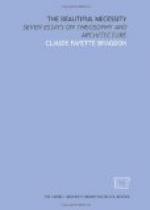[Illustration 78]
[Illustration 79]
[Illustration 80]
[Illustration 81]
Every building is a symbol of some number or group of numbers, and other things being equal the more perfect the numbers involved the more beautiful will be the building (Illustrations 76-82). The numbers 5 and 7—those which occur oftenest—are the most satisfactory because being of small quantity, they are easily grasped by the eye, and being odd, they yield a center or axis, so necessary in every architectural composition. Next in value are the lowest multiples of these numbers and the least common multiples of any two of them, because the eye, with a little assistance, is able to resolve them into their constituent factors. It is part of the art of architecture to render such assistance, for the eye counts always, consciously or unconsciously, and when it is confronted with a number of units greater than it can readily resolve, it is refreshed and rested if these units are so grouped and arranged that they reveal themselves as factors of some higher quantity.
[Illustration 82]
[Illustration 83: A NUMERICAL ANALYSIS OF GOTHIC TRACERY]
There is a raison d’etre for string courses other than to mark the position of a floor on the interior of a building, and for quoins and pilasters other than to indicate the presence of a transverse wall. These sometimes serve the useful purpose of so subdividing a facade that the eye estimates the number of its openings without conscious effort and consequent fatigue (Illustration 82). The tracery of Gothic windows forms perhaps the highest and finest architectural expression of number (Illustration 83). Just as thirst makes water more sweet, so does Gothic tracery confuse the eye with its complexity only the more greatly to gratify the sight by revealing the inherent simplicity in which this complexity has its root. Sometimes, as in the case of the Venetian Ducal Palace, the numbers involved are too great for counting, but other and different arithmetical truths are portrayed; for example, the multiplication of the first arcade by 2 in the second, and this by 3 in the cusped arches, and by 4 in the quatrefoils immediately above.
[Illustration 84: NUMERATION IN GROUPS EXPRESSED ARCHITECTURALLY]
[Illustration 85: ARCHITECTURAL ORNAMENT CONSIDERED AS THE OBJECTIFICATION OF NUMBER. MULTIPLICATION IN GROUPS OF FIVE; TWO; THREE; ALTERNATION OF THREE AND SEVEN]




